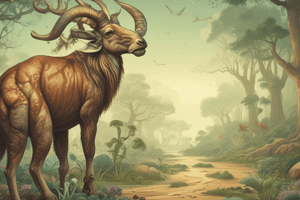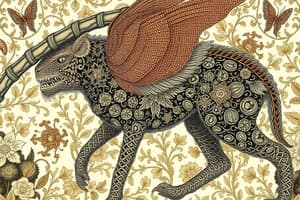Podcast
Questions and Answers
What characterizes homologous structures?
What characterizes homologous structures?
- They are similar structures that evolve from a common ancestor. (correct)
- They are always used in the same way by different species.
- They perform similar functions but do not share a common ancestor.
- They evolve independently in response to similar environmental pressures.
Which of the following is an example of analogous structures?
Which of the following is an example of analogous structures?
- Bones in the forelimbs of humans and whales
- Thorns of Bougainvillea and Cucurbita
- Roots of sweet potatoes and stems of potatoes (correct)
- Wings of bats and birds
What does artificial selection primarily involve?
What does artificial selection primarily involve?
- Breeding selected plants and animals for specific traits. (correct)
- Natural processes selecting advantageous traits.
- Preservation of species without human intervention.
- Evolution through mutations in the wild.
What did the observations of moths in England after industrialization demonstrate?
What did the observations of moths in England after industrialization demonstrate?
What do biochemical similarities among different organisms suggest?
What do biochemical similarities among different organisms suggest?
Flashcards
Homologous Structures
Homologous Structures
Similar structures in different organisms derived from a shared ancestor, even if their functions differ.
Analogous Structures
Analogous Structures
Structures that share a similar function but do not share a common evolutionary origin.
Artificial Selection
Artificial Selection
Humans selectively breeding plants or animals with desired traits for agriculture, horticulture, or other purposes.
Natural Selection (Moths)
Natural Selection (Moths)
Signup and view all the flashcards
Biochemical Similarities
Biochemical Similarities
Signup and view all the flashcards
Study Notes
Homology and Analogy
- Homology: Divergent evolution, similar structures with different functions (e.g., wings of butterfly and birds)
- Analogy: Convergent evolution, similar functions with different structures (e.g., thorns and tendrils in plants)
Examples of Analogy
- Sweet potato (root modification) and potato (stem modification)
- Eyes of octopus and mammals, flippers of penguins and dolphins
Biochemical Similarities
- Similarities in proteins and genes indicate common ancestry
- These similarities can point to shared ancestry for organisms
Selective Breeding
- Humans have bred plants and animals for agriculture, horticulture, sport or security
- Domesticated many wild animals and crops
- Intensive breeding programs create diverse breeds within the same species
- Question: If humans can create new breeds in a short time, can natural selection cause similar changes over millions of years?
Moth Example
- Observation in England (before industrialization): more white-winged moths on trees than dark-winged moths
- Observation in England (after industrialization): more dark-winged moths on trees in same area
Studying That Suits You
Use AI to generate personalized quizzes and flashcards to suit your learning preferences.




